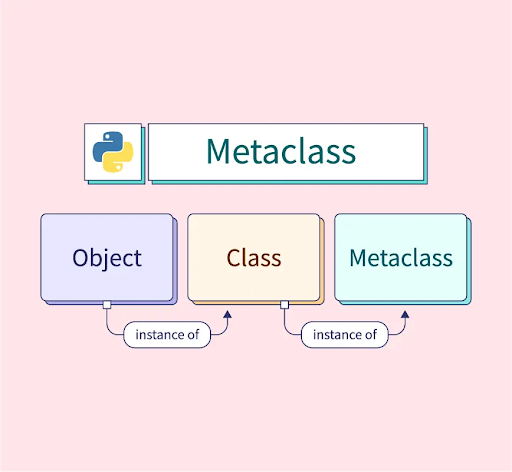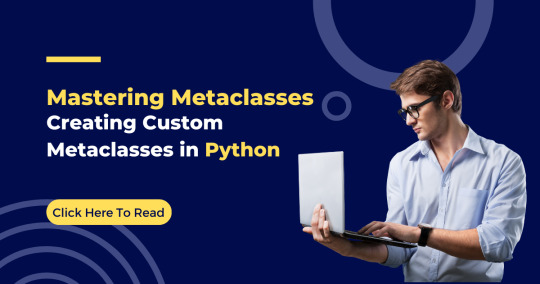#Metaprogramming with Metaclasses
Explore tagged Tumblr posts
Text
Metaclasses – Python’s Object-Oriented Paradigm and Its Metaprogramming

Welcome to Python Metaclasses! To truly grasp the concept of metaclasses, we need to start by understanding a fundamental principle of Python: everything is an object. Yes, that includes classes themselves. We’ll explore the nature of objects, the functionality of the type() function, how classes instantiate objects, and the intriguing process of instantiating classes, which are objects in their own right. We’ll also discover how to tap into this mechanism to achieve remarkable results in our code.
Once we’ve covered the fundamental concepts of metaclasses, we’ll dive into a real-world example: the Enum class and its companion, the EnumType. This case study will showcase how metaclasses can be used effectively in practice.

Exploring Types and Unveiling Objects: Demystifying the type() Function
Python considers everything to be an object, and each object has a type that describes its nature. Numbers, for example, are of the type “int”, text is of the type “str”, and instances of a custom Person object are of the type “Person” class.
The type() method is a useful tool for determining the type of an object. Let’s experiment with it in the Python REPL. For example, when we create a list and use type() on it, we discover that it is an object instance of the “list” class. We can also ascertain the type of a string, such as “cat,” which is, predictably, “str”. In Python, even individual letters are considered strings, unlike some other programming languages that distinguish between characters and strings.
In fact, the “type” function is at the top of the class hierarchy. Just as calling “str()” on an object returns its string representation, calling “type()” on an object returns its type equivalent. It’s worth reiterating that “type” is the highest point in this hierarchy. We can confirm this by observing that the type of “type” is also “type”.
>>> print(type(1)) <type 'int'> >>> print(type("1")) <type 'str'> >>> print(type(ObjectCreator)) <type 'type'> >>> print(type(ObjectCreator())) <class '__main__.ObjectCreator'>
Well, type has also a completely different ability: it can create classes on the fly. type can take the description of a class as parameters, and return a class.
type works this way:
type(name, bases, attrs)
Where:
name: name of the class
bases: tuple of the parent class (for inheritance, can be empty)
attrs: dictionary containing attributes names and values
type accepts a dictionary to define the attributes of the class. So:
>>> class Foo(object): ... bar = True
Can be translated to:
>>> Foo = type('Foo', (), {'bar':True})
And used as a normal class:
>>> print(Foo) <class '__main__.Foo'> >>> print(Foo.bar) True >>> f = Foo() >>> print(f) <__main__.Foo object at 0x8a9b84c> >>> print(f.bar) True
You see where we are going: in Python, classes are objects, and you can create a class on the fly, dynamically.
This is what Python does when you use the keyword class, and it does so by using a metaclass.
Discovering Python’s Class Instantiation
Dynamic class creation is a great Python feature that allows us to construct classes on the fly, giving our code flexibility and extensibility. In this section, we will look at how to construct classes dynamically using metaprogramming techniques.
But it’s not so dynamic, since you still have to write the whole class yourself.
Since classes are objects, they must be generated by something.
When you use the class keyword, Python creates this object automatically. But as with most things in Python, it gives you a way to do it manually.
Dynamic class creation is the foundation of metaclasses, which are classes that define the behavior of other classes. Metaclasses allow us to intercept class creation and modify attributes, methods, and behavior before the class is fully formed. However, exploring metaclasses goes beyond the scope of this section, as it requires a deeper understanding of Python’s metaprogramming capabilities.
What are metaclasses (finally)
Metaclasses are the ‘stuff’ that creates classes.
You define classes in order to create objects, right?
But we learned that Python classes are objects.
Why would you use metaclasses instead of function?
The main use case for a metaclass is creating an API. A typical example of this is the Django ORM. It allows you to define something like this:
class Person(models.Model): name = models.CharField(max_length=30) age = models.IntegerField()
But if you do this:
person = Person(name='bob', age='35') print(person.age)
It won’t return an IntegerField object. It will return an int, and can even take it directly from the database.
This is possible because models.Model defines __metaclass__ and it uses some magic that will turn the Person you just defined with simple statements into a complex hook to a database field.
Django makes something complex look simple by exposing a simple API and using metaclasses, recreating code from this API to do the real job behind the scenes.
Conclusion
Although magicians are not meant to share their secrets, understanding metaclasses allows you to solve the puzzle for yourself. You’ve learned the key behind several of Python’s finest techniques, including class instantiation and object-relational mapping (ORM) models, as well as Enum.
It’s worth mentioning that creating bespoke metaclasses isn’t always necessary. If you can address the problem in a more straightforward manner, you should probably do so. Still, understanding metaclasses will help you understand Python classes in general and recognise when a metaclass is the best tool to utilize.
Originally published by: Metaclasses – Python’s Object-Oriented Paradigm and Its Metaprogramming
#Metaclasses in Python#Metaprogramming with Metaclasses#OOP in Python#Python Metaclasses#Python Object Oriented Paradigm
0 notes
Text
Learn MetaClass in Java with this tutorial, covering dynamic class creation, reflection, and advanced Java metaprogramming concepts for efficient and flexible code design.
0 notes
Text
Metaprogramming in Python enables dynamic code generation by using features like decorators, metaclasses, and introspection. It allows programs to modify or create code at runtime, enhancing flexibility, automation, and adaptability for solving complex, dynamic, or repetitive programming tasks.
0 notes
Text
Price: [price_with_discount] (as of [price_update_date] - Details) [ad_1] Don't waste time bending Python to fit patterns you've learned in other languages. Python's simplicity lets you become productive quickly, but often this means you aren't using everything the language has to offer. With the updated edition of this hands-on guide, you'll learn how to write effective, modern Python 3 code by leveraging its best ideas.Discover and apply idiomatic Python 3 features beyond your past experience. Author Luciano Ramalho guides you through Python's core language features and libraries and teaches you how to make your code shorter, faster, and more readable.Complete with major updates throughout, this new edition features five parts that work as five short books within the book:Data structures: Sequences, dicts, sets, Unicode, and data classesFunctions as objects: First-class functions, related design patterns, and type hints in function declarationsObject-oriented idioms: Composition, inheritance, mixins, interfaces, operator overloading, protocols, and more static typesControl flow: Context managers, generators, coroutines, async/await, and thread/process poolsMetaprogramming: Properties, attribute descriptors, class decorators, and new class metaprogramming hooks that replace or simplify metaclasses ASIN : B09WZJMMJP Publisher : O'Reilly Media; 2nd edition (31 March 2022) Language : English File size : 13420 KB Simultaneous device usage : Unlimited Text-to-Speech : Enabled Enhanced typesetting : Enabled X-Ray : Not Enabled Word Wise : Not Enabled Print length : 1016 pages [ad_2]
0 notes
Text
How do I become an expert Python programmer?
Become an Expert Python Programmer
To become an expert in Python programming, one needs dedication, constant practice, and a deep understanding of the language. What follows is a roadmap to get you started:
1. Mastering the Basics
Get a good understanding of core concepts: Make sure to really clearly understand syntax, data types, control flow, functions, and object-oriented programming.
Regular Practice: Keep solving coding challenges and be engaged with small projects. Experiment with different ways of doing things.
2. Deep Dive into Python
Advanced topics: mastering modules, packages, exception handling, and debugging techniques.
Functional programming: higher order functions, lambda expressions, generators
Metaprogramming: decorators, metaclasses, introspection
3. Data Structures and Algorithms
Master the basic data structures: lists, tuples, dictionaries, sets; how to use them efficiently.
Understand algorithms: sorting, searching, and other basic algorithms.
Analyze complexity: time/space complexity of algorithms.
4. Exploit Python Libraries
Explore popular libraries: Learn how to work with NumPy, Pandas, Matplotlib, Scikit-learn, and others.
Understand their internal structure: Study the source code of the libraries.
Participate in open-source projects: Work together with the community to build your skills.
5. Master Basics of Data Science
Statistics and probability: Understand mathematical assumptions that lie behind the analysis of data.
Learn machine learning: Various algorithms and their applications.
Deep learning mastery: Knowing neural networks and their architectures.
6. Continuous Learning and Practice
Be informed: Know about the trends in Python, its newest libraries, and good practices.
Contribution to open source: Contribute and collaborate on others' works.
Build Projects: Apply your skills to problems, bring them into life to create a portfolio.
Learn from Others: Join online communities; attend conferences, and read books.
Other Tips
Follow the PEP 8 style guide while writing clean, readable code.
Optimize code for performance: Find bottlenecks and make them efficient.
Test your code: Add comprehensive unit and integration tests.
Collaborate with others: Learn from knowledgeable programmers; vice versa, share yours. Remember, only with time and dedication does one get expertise. Focus on building a strong base and then try to gradually expand your knowledge.
0 notes
Text
Mastering Metaclasses: Creating Custom Metaclasses in Python

Metaclasses are an advanced topic in Python that can greatly enhance your programming skills, making them valuable additions to a Python course online. Understanding metaclasses and their usage empowers learners to customize class creation and behavior, unlocking the full potential of metaprogramming. In this blog post, we will explore the concept of metaclasses, discuss their role in Python, and delve into creating custom metaclasses.
Understanding Metaclasses
Teaching metaclasses in a Python course introduces learners to a powerful Python feature where classes can be manipulated. Metaclasses define the rules for creating classes and allow learners to customize class behavior at a higher level than regular class definitions. By grasping the concept of metaclasses, learners can expand their metaprogramming skills and gain a deeper understanding of Python's class system.
The type Metaclass
Explaining the default metaclass, type, is crucial when teaching metaclasses. The type metaclass creates classes when defined using the class keyword. It serves as the foundation for understanding custom metaclass creation. Learners should understand that the type metaclass can be subclassed to create custom metaclasses.
Creating Custom Metaclasses
Learners should be guided through creating custom metaclasses in a Python or Python course online. This involves defining a new class that derives from a type or another metaclass. Learners can control class creation and modification by overriding specific methods or attributes. Methods like __new__(), __init__(), and __call__() can be overridden to inject additional behavior or dynamically modify class attributes.
Use Cases for Custom Metaclasses:
Exploring use cases for custom metaclasses helps learners understand the practical applications of this advanced feature. Some examples include:
● Adding or modifying class attributes automatically.
● Implementing class registries or object tracking systems.
● Enforcing coding conventions and design patterns.
● Implementing data validation or manipulation during class creation.
● Creating domain-specific languages (DSLs) or declarative programming constructs.
Metaclass Inheritance and Multiple Inheritance:
Teaching learners about metaclass inheritance and multiple inheritance demonstrates the flexibility of metaclasses. Learners can create metaclasses that inherit from other metaclasses or regular classes, allowing for combining functionalities and behaviors.
Best Practices and Caveats
Providing best practices and highlighting potential caveats when working with metaclasses is important for learners. It ensures they understand how to use metaclasses effectively and avoid unnecessary complexities. Emphasizing documentation and maintainability helps learners apply custom metaclasses clearly and readably.
Understanding metaclasses in Python is an advanced metaprogramming concept significantly enhances Python programming skills. Including metaclasses in Python or online courses empowers learners to customize class creation and behavior. By teaching the concept of metaclasses, guiding learners through creating custom metaclasses, showcasing use cases, discussing metaclass inheritance, and highlighting best practices, learners can unlock the full potential of metaprogramming.
Metaclasses give learners a powerful toolset for shaping class behavior to suit their needs. Mastery of metaclasses allows learners to become proficient in advanced Python programming techniques and apply metaprogramming principles effectively.
0 notes
Note
are you willing to convert to the religion of compile-time metaclass template metaprogramming
I’ve been metaprogramming(C++) where I should ever since I realized I could basically program the compiler itself to program for me and basically get the compiler to do some cool tricks with zero run-time overhead. Love it!
I use it a lot in my AFX plugins to abstract away the idea of a 8,16,32-bit color space and so I can write a function once and that totally abstract away bit depth and at compile-time it automatically generates the same function for all color depths at once(and automatically handles saturation and pixel sizes and such).

29 notes
·
View notes
Text
Advanced Python Interview Questions
Besides coding knowledge, hiring managers look at candidates’ ability to answer complex questions and think on their feet. They look for the certainty that developers are agile and will not duplicate functionalities.

Below, we list a few python advanced interview questions and answers that candidates can prepare for interviews.
1. What are virtualenvs?
Answer: Remote Python developers refer to a virtualenv as an isolated environment to develop, run, and debug Python code. You can achieve this by isolating a Python interpreter, together with a set of libraries and settings. Alongside pip, virtualenvs helps developers run and deploy many applications on a single host. Each one contains a Python interpreter version and a separate set of libraries.
2. What are the Wheels and Eggs? What is the difference?
Answer: Wheel and Egg are packaging formats that support the use case of needing an install artefact without building or compilation – otherwise costly in testing and production workflows. Setuptools introduced the Egg format in 2004, while PEP 427 introduced the Wheel format in 2012. Wheel is the current standard for built and binary packaging for Python programming language.
3. What are the usages of nonlocal and global keywords?
Answer: Developers use the nonlocal and global keywords to change the scope of a previously declared variable. Developers use nonlocal to access a variable in a nested function. On the other hand, global makes a previously-declared variable global. It’s a relatively straightforward function.
4. What is the function of self?
Answer: As a variable, self represents the instance of the object to itself. Typically, most object-oriented programming languages pass on this method as a hidden parameter defined by an object. However, in Python programming language, the variable isn’t implied. It is declared and passed explicitly. It is the first argument created in the instance of the class A. Consequently, the parameters to the methods are passed automatically.
5. What is the difference between classmethod and staticmethod?
Answer: Both refer to a class method that can be called without instantiating an object of the class. The only difference lies in their respective signatures.
6. What is GIL? What are the ways to get around it?
Answer: GIL or Global Interpreter Lock is a mechanism Python uses for concurrency. One of its biggest drawbacks is that it locks the interpreter, making concurrent threading difficult. The process can result in major performance losses.
7. What are metaclasses, and when are they used?
Metaprogramming in Python is a vast and intriguing topic. Metaclasses refer to classes for classes. A metaclass can ascertain a common behaviour for many classes – specifically in cases when inheritance will get messy. An example of a metaclass is ABCMeta, which creates abstract classes.
8. What are generator functions?
Generator functions can suspend their execution after returning a value. They resume at a later time and return another value. Use the yield keyword instead of return to make this possible.
9. What are decorators in Python Programming?
Python developers use decorators to modify the behaviours of functions. Decorators come prefixed with the @ symbol and placed right before a function declaration.
10. What is pickling and unpickling in Python?
Pickling is another word for serializing. Pickling is a process that allows you to serialize an object into anything you choose – a string, for instance. The function enables objects to be persisted on storage or sent over the network. On the other hand, unpickling restores the original object from a pickled string.
0 notes
Text
Fluent Python - Luciano Ramalho
Fluent Python Luciano Ramalho Genre: Computers Price: $42.99 Publish Date: July 30, 2015 Publisher: O'Reilly Media Seller: O Reilly Media, Inc. Python’s simplicity lets you become productive quickly, but this often means you aren’t using everything it has to offer. With this hands-on guide, you’ll learn how to write effective, idiomatic Python code by leveraging its best—and possibly most neglected—features. Author Luciano Ramalho takes you through Python’s core language features and libraries, and shows you how to make your code shorter, faster, and more readable at the same time. Many experienced programmers try to bend Python to fit patterns they learned from other languages, and never discover Python features outside of their experience. With this book, those Python programmers will thoroughly learn how to become proficient in Python 3. This book covers: Python data model: understand how special methods are the key to the consistent behavior of objects Data structures: take full advantage of built-in types, and understand the text vs bytes duality in the Unicode age Functions as objects: view Python functions as first-class objects, and understand how this affects popular design patterns Object-oriented idioms: build classes by learning about references, mutability, interfaces, operator overloading, and multiple inheritance Control flow: leverage context managers, generators, coroutines, and concurrency with the concurrent.futures and asyncio packages Metaprogramming: understand how properties, attribute descriptors, class decorators, and metaclasses work http://dlvr.it/R0kC93
0 notes
Photo

Python Metaclasses
The term metaprogramming refers to the potential for a program to have knowledge of or manipulate itself. Python supports a form of metaprogramming for classes called metaclasses. Metaclasses are an esoteric OOP concept, lurking behind virtually all Python code. You are using them whether you are aware of it or not. For the most part, […]
The post Python Metaclasses appeared first on PyBloggers.
0 notes
